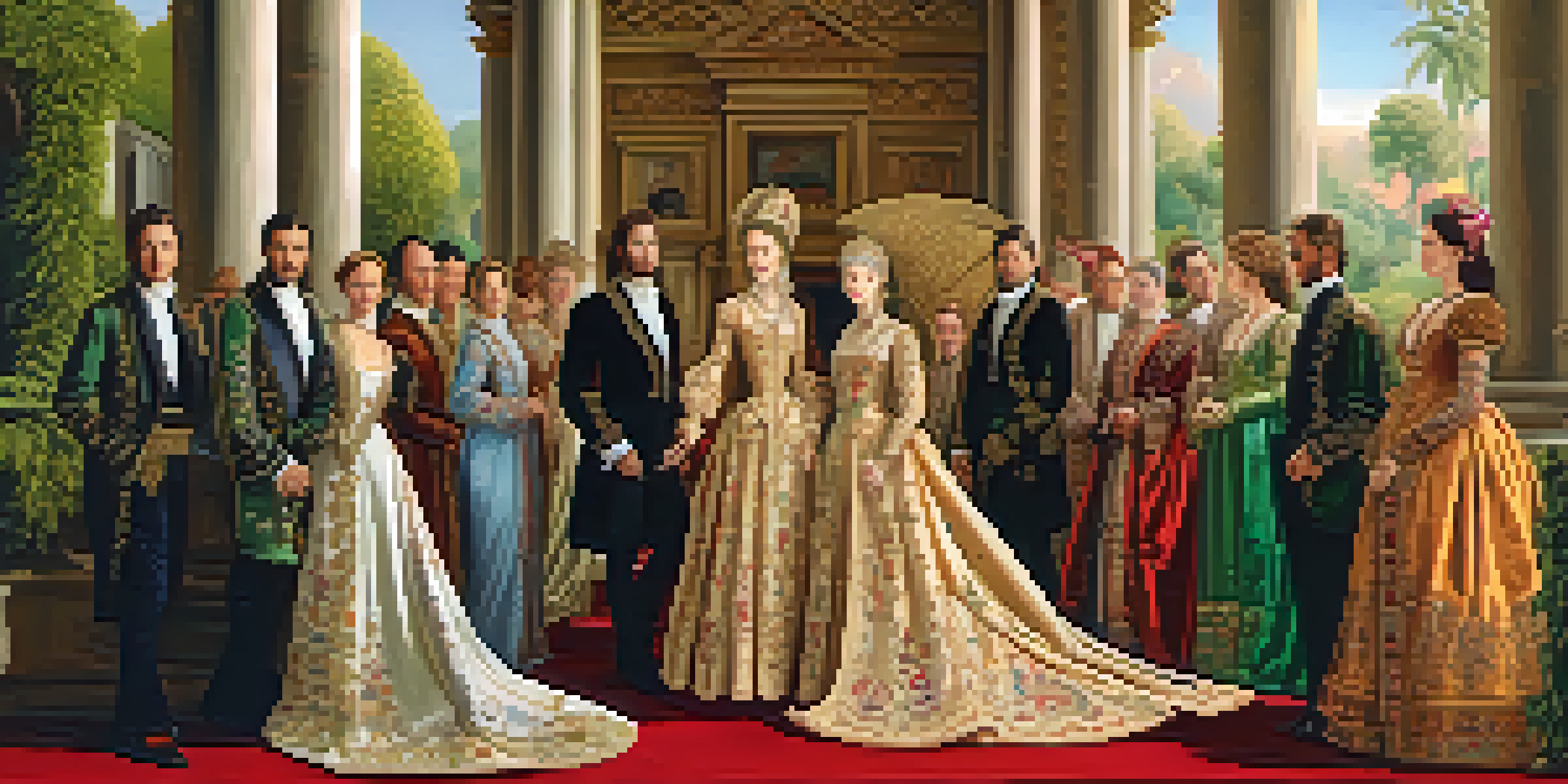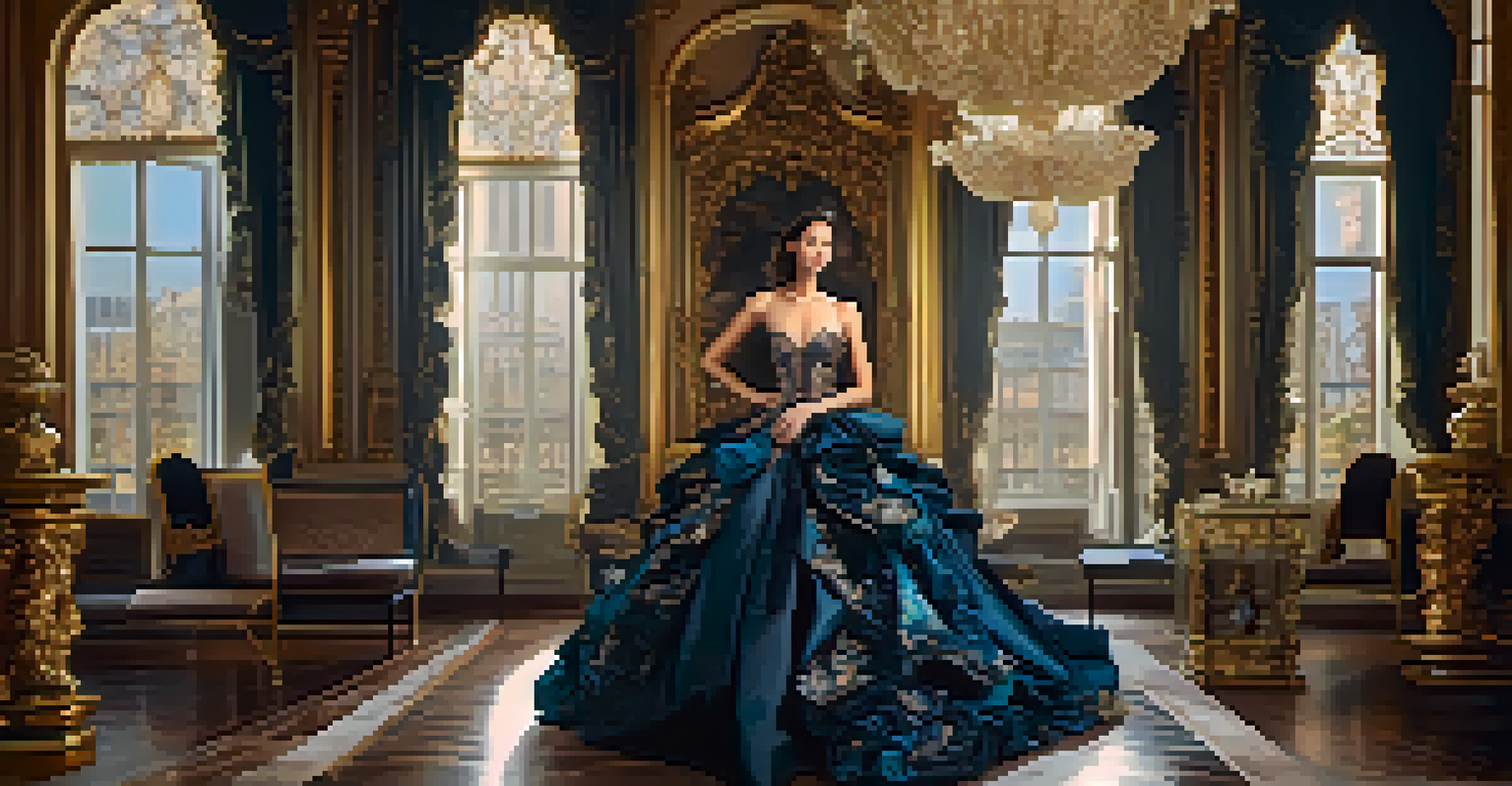Historical Art Movements That Shaped Fashion Design

The Renaissance: Where Art and Fashion Began to Flourish
The Renaissance, spanning from the 14th to the 17th century, was a pivotal era that bridged the gap between the Middle Ages and modernity. Artists like Leonardo da Vinci and Michelangelo not only transformed the world of painting and sculpture but also influenced fashion with their emphasis on realism and human form. Rich textiles and intricate designs became the hallmark of this period, laying the groundwork for future fashion trends.
Fashion is the armor to survive the reality of everyday life.
Fashion during the Renaissance was characterized by opulence, with garments often adorned with elaborate embroidery and luxurious fabrics. The use of color and texture reflected the artistic innovations of the time, creating garments that were not just clothing but wearable art. This era taught designers to appreciate the interplay between art and fashion, a relationship that continues to thrive today.
The legacy of the Renaissance is evident in contemporary fashion, where designers frequently draw inspiration from classic art forms. The attention to detail and the celebration of human beauty from this period still resonate in today’s haute couture. Thus, the Renaissance serves as a significant foundation for the artistic expression we see in modern fashion.
Baroque: Drama and Extravagance in Fashion
The Baroque period, emerging in the 17th century, is known for its dramatic flair and exuberance in both art and fashion. This movement embraced bold colors, rich textures, and extravagant designs, which influenced the way clothing was constructed and worn. Think of the lavish gowns adorned with lace and ruffles, which mirrored the grandiosity of Baroque art.

Fashion during this time was all about making a statement, much like the artwork of Caravaggio or Rembrandt, which captivated audiences with their emotional depth and intricate detail. The theatricality of Baroque fashion encouraged wearers to express their status and personality, often through elaborate costumes that turned heads. This idea of clothing as a form of artistic expression is something that continues to be relevant in fashion today.
Renaissance: Art Meets Fashion
The Renaissance era laid the foundation for modern fashion by intertwining artistic expression with clothing design.
Even in modern fashion shows, we can see echoes of Baroque style in the use of dramatic silhouettes and ornate embellishments. Designers often pay homage to this era by incorporating rich fabrics and bold patterns into their collections. The Baroque period not only shaped fashion but also taught future generations the power of presentation in both art and attire.
Romanticism: Embracing Emotion in Fashion Design
The Romanticism movement, which flourished in the late 18th and early 19th centuries, was all about emotion, nature, and individualism. This artistic shift encouraged freedom of expression, and fashion began to reflect the sentiments of the time, with flowing silhouettes and soft fabrics that evoked a sense of movement and grace. Romanticism pushed designers to think beyond the structured garments of previous eras.
Clothes mean nothing until someone lives in them.
In fashion, this translated into the use of lightweight materials and softer colors, often inspired by nature and the human experience. The Romantic dress style was characterized by high waistlines and flowing skirts, often seen in the iconic gowns of the period. This allowed wearers to express their feelings and personalities through their clothing, fostering a deeper connection between art and self-identity.
Modern fashion designers often revisit the principles of Romanticism, infusing their collections with emotional depth and storytelling. The emphasis on comfort and personal expression in today's clothing choices can be traced back to this movement. By looking to the past, fashion continues to evolve while maintaining its core essence of individuality and emotion.
Art Nouveau: The Fusion of Art and Fashion
Art Nouveau, which emerged in the late 19th century, is characterized by its organic forms and intricate patterns inspired by nature. This movement not only influenced visual arts but also made a significant impact on fashion design, with flowing lines and floral motifs becoming the norm. Designers began to break away from rigid structures, embracing the beauty of nature in their creations.
The garments of the Art Nouveau period often featured sinuous shapes and elaborate embellishments, reflecting the artistic ideals of the time. This era encouraged designers to adopt a more holistic approach, merging art with the functionality of clothing. The result was a whimsical, yet elegant, style that appealed to the sensibilities of a modernizing world.
Sustainable Fashion's Rise
Sustainable fashion represents a significant contemporary movement, emphasizing eco-friendly practices and ethical creativity.
Today, Art Nouveau continues to inspire fashion designers who look to nature for patterns and forms. The emphasis on craftsmanship and artistic elements in clothing mirrors the ideals of this movement. By integrating art into everyday wear, designers keep the spirit of Art Nouveau alive, celebrating the interconnectedness of art and fashion.
Modernism: Minimalism and the Bauhaus Influence
The Modernist movement, which began in the early 20th century, was a response to the complexities of the world, leading to a focus on simplicity and functionality. This era saw the rise of Minimalism, with clean lines and unfussy designs dominating the fashion landscape. The Bauhaus school, in particular, emphasized the idea that form follows function, a principle that reshaped how clothing was designed.
Fashion during this time moved away from excessive ornamentation, favoring practicality and sustainability. Designers like Coco Chanel challenged traditional notions of femininity by introducing more utilitarian styles, such as the famous little black dress. This shift allowed individuals to express themselves through streamlined silhouettes rather than elaborate decorations.
Modernism's impact is still prevalent in today's fashion, where minimalism remains a popular choice for many designers. The emphasis on simplicity allows for versatility and timelessness in clothing, creating pieces that can be worn across different occasions. As we continue to navigate a fast-paced world, the lessons of Modernism remind us of the beauty found in simplicity.
Postmodernism: Breaking Boundaries in Fashion
Postmodernism emerged in the late 20th century as a reaction against the ideals of Modernism, encouraging experimentation and the blurring of boundaries in both art and fashion. This movement embraced eclecticism, allowing designers to mix styles, textures, and patterns in a way that had previously been considered taboo. It was a celebration of individuality and a rejection of the idea that there was a single way to express oneself through clothing.
Fashion icons like Vivienne Westwood and Jean-Paul Gaultier became known for their daring designs that challenged conventions. They played with gender norms and cultural references, creating garments that were not just clothes but statements. This radical approach to fashion encouraged wearers to embrace their uniqueness, fostering a sense of community among those who celebrated diversity.
Postmodernism: Embracing Individuality
Postmodernism in fashion celebrates eclecticism and individuality, encouraging a mix of styles that reflect personal identity.
Today, postmodern influences can be seen in the rise of streetwear and the blending of high fashion with everyday styles. The freedom to mix and match, to play with identity through clothing, remains a core principle in contemporary fashion. By breaking down barriers, postmodernism has allowed fashion to become a true reflection of the diverse world we live in.
Sustainable Fashion: The Art Movement of Our Time
In recent years, the conversation around sustainable fashion has gained momentum, positioning it as the art movement of our time. This shift is driven by a growing awareness of environmental issues and the need for ethical practices in the fashion industry. Designers are now embracing eco-friendly materials and innovative techniques that minimize waste while still prioritizing aesthetic appeal.
Sustainable fashion encourages creativity, as designers seek to find new ways to produce clothing that respects the planet. This movement draws inspiration from various art movements, integrating elements of Minimalism and Modernism to create functional yet beautiful pieces. The emphasis on craftsmanship and sustainability reflects a deeper understanding of our connection to the world around us.

As consumers become more conscious of their choices, the demand for sustainable fashion continues to rise. This movement not only challenges traditional fashion norms but also inspires a new generation of designers who prioritize ethical practices. By blending art with sustainability, fashion is evolving into a platform for positive change, making it one of the most significant movements in contemporary society.